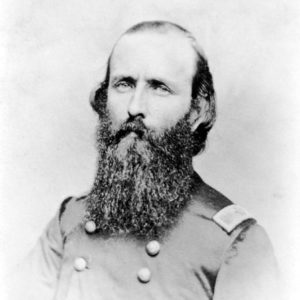calsfoundation@cals.org
Military Farm Colonies (Northwestern Arkansas)
During the Civil War, thousands of Arkansas civilians became displaced and relied on either the Federal or Confederate governments to provide basic necessities. These non-combatants strained military resources, and commanders searched for ways to make these refugees self-sufficient. With many Unionist families in northwestern Arkansas, Federal commanders created a program that allowed groups to grow subsistence crops and work together to provide mutual self-defense from enemy units. The colonies in northwestern Arkansas were established around the families of white Unionists, while other colonies in central and eastern Arkansas were populated by freedmen and their families.
By the spring of 1864, years of war had taken a toll on the agricultural output of northwestern Arkansas, and thousands of people were forced to move to Federal posts in order to obtain food. By May 1864, about 1,000 refugees were at Fort Smith (Sebastian County), and another 1,000 were at Fayetteville (Washington County), relying on support from the Union troops stationed in those towns. Some commanders distributed food to the families of Union soldiers, while others gave cash to women and children in need.
Colonel Marcus LaRue Harrison of the First Arkansas Cavalry (US) wanted to help refugees provide their own sustenance and, by May 1864, was using a home-guard company to guard farms near Pea Ridge (Benton County). An order soon followed that authorized the establishment of such companies to guard loyal farms, and Harrison set out to create a system of farms across the region, called military farm colonies. At the same time, Major General Joseph Reynolds ordered the commander of Fort Smith, Brigadier General Cyrus Bussey, to establish units of soldiers to farm using government-supplied implements and animals. Any food grown at these farms would take some of the pressure off already stretched Federal supply lines.
Harrison created a set of instructions for the establishment of the farm colonies. To begin the process for each colony, at least fifty men who were capable of bearing arms and who would sign an oath of loyalty to the Union were required. Their families would be settled together and would all farm one large tract of land—each was responsible for their own crop and relied on one another only for mutual defense. The land was distributed by vote, and each family received all that they wished to farm. In order to defend themselves effectively, the colonies were required to construct a blockhouse or small fort at a location selected by Harrison. All people living within ten miles of a colony were required to record their names on the roster. Any who refused were deemed to be rebels.
The colonies grew a number of subsistence crops, including corn, potatoes, onions, and wheat. Other crops such as hay and oats were also grown as fodder for farm animals. The land used by the families was not officially seized by the Union army or any other organization. Rather, the civilians at the farm colonies were technically squatters. Other services beyond growing crops were also offered at some of the colonies. At Union Valley in Washington County, a blacksmith shop, church, and public school were all available to members of the colony. The countryside became depopulated as the colonies were established.
Four colonies were created in the areas of Fort Smith and Van Buren (Crawford County) under the direction of Bussey. Another seventeen were under the command of Harrison, spread across Washington, Madison, and Benton counties. About 1,200 men lived in these seventeen colonies, along with women and children. The colonies under Harrison also put around 15,000 acres of land back into agricultural use, taking some of the supply strain off Federal forces. Governor Isaac Murphy recognized the success of the project and pushed Harrison to establish additional colonies, but the officer was unable to do so because he lacked enough men to protect the colonies.
The colonies were successful in offering mutual protection for Union families while providing for their own protection from possible Confederate and guerrilla threats. The men of at least two colonies did participate in active field operations against Confederate forces during the war, although most never saw action while at the colonies. One company operated in the field for almost one year, while two others participated in defending Fayetteville from enemy attack on November 3, 1864.
General Bussey did not approve of the colonies and worked to undermine any success that might come from the experiment. Colonel Harrison was Bussey’s direct subordinate, and the two did not agree on the necessity of the colonies. Although Bussey consistently reported to his commander in Little Rock (Pulaski County) that the experiment was not only unnecessary but likely to fail, he was unable to stop Harrison from supporting the colonies. Despite this lack of support, the colonies were successful in easing the strain on Federal outposts and in providing self-defense forces that could effectively protect the civilians in northwestern Arkansas.
The end of the war saw the demise of the military farm colonies. As landowners returned to reclaim their property, families working the land at the colonies were forced to depart. While the colonies existed for only a year at most during the war, they did provide an effective way for civilians to become self-sufficient.
For additional information:
Bishop, Albert. Report of the Adjutant General of Arkansas. Washington DC: 1867.
Hughes, Michael. “Wartime Gristmill Destruction in Northwest Arkansas and Military-Farm Colonies.” Arkansas Historical Quarterly 46 (Summer 1987): 167–186.
The War of the Rebellion: A Compilation of the Official Records of the Union and Confederate Armies. Series 1, Vols. 34, 41, 48. Washington DC: Government Printing Office, 1889.
David Sesser
Henderson State University
 Civil War through Reconstruction, 1861 through 1874
Civil War through Reconstruction, 1861 through 1874 Military Farm Colonies (Arkansas Delta)
Military Farm Colonies (Arkansas Delta) Union Occupation of Arkansas
Union Occupation of Arkansas ACWSC Logo
ACWSC Logo  M. LaRue Harrison
M. LaRue Harrison 




Comments
No comments on this entry yet.